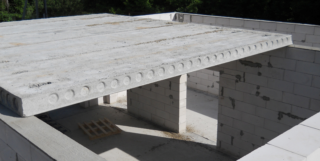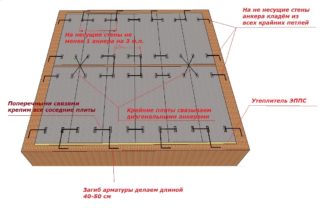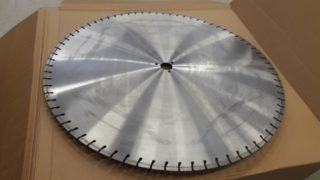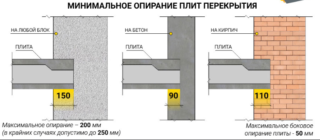Reinforced concrete slabs are used in the load-bearing frame of buildings, blocking tunnels and heating mains. The correct laying of floor slabs is important for the strength and durability of the structure. The panels are made by concreting in molded formwork, the products are delivered to the construction site and assembled in the design position. Structures are tested for strength and other indicators in the factory, and the quality of the installation is checked at the installation site.
Varieties of floor slabs

The panels are made from quality components in accordance with the manufacturing technology. The slabs withstand a high load due to the reinforcement frame, therefore, they are used for load-bearing barriers in normal conditions and in seismological hazardous regions.
Products differ in the manufacturing method in accordance with GOST 26.434 - 1985:
- PC - formwork production;
- PB is a non-formwork method.
In the first case, ready-made formwork with installed reinforcing structures is used. Concrete of the required grade is placed in the molds, subjected to vibration, passes through the steam chambers and solidifies. For the frame, bar steel AT-IV, AT-V, AT-VI (stressed) and A-II, A-III (unstressed) are used. Transverse reinforcement is made with a metal mesh.

Quality control confirms the properties:
- compressive strength, bending, torsion;
- conformity of planes and dimensions;
- indicators of sound and heat insulation.
Formwork is carried out on a conveyor belt. The conveyor moves a reinforced concrete belt, in the thickness of which there are steel ropes. The strip is molded, then insulated with a special material and heated to the technological temperature in order to speed up the chemical processes. The tape is cut to size after solidification.
Formwork without form has the advantage that production can be quickly switched over to different panel sizes. The extruder method is a type of form-less formation, for which a smoothing mechanism is used to level the surface of the product and prevent cracks.
Difference in type of work and construction

Hollow core panels are placed in load-bearing ceilings between building levels and roofs. They resist temperature extremes, are distinguished by increased sound insulation, and prevent the spread of flame in case of fire. The thickness is 220 mm, round, oval or square through holes are made in the body along the length.
Ribbed products are used for covering and covering large areas, for example, gyms, workshops, shopping centers. The main body of the rectangular slab is flat; stiffeners are made along the longitudinal sides. The disadvantage is that the ceiling is ribbed, and the advantage is that it is highly resistant to mechanical stress.
Solid slabs are distinguished by a large mass, high strength in comparison with other slab products. They are used in the construction of heavily loaded floors of floors and basements, where there is a lot of weight and vibration forces.
Panels with slanting ends are used in frame and monolithic construction, when building from large blocks, brick stones.Monolithic products represent a concrete slab with reinforcement, are used in residential and industrial construction of buildings with strong vibration forces.
Complementary solid panels are made of concrete grades M450, M500, due to which they withstand 1 - 3 t / m². They are used in heavily loaded floors, they can be placed on the plinths and foundations of industrial workshops, power plants. Lightweight floor slabs are made with numerous voids, which is why they are lightweight.
Extruder plates are widely used in various buildings, they contain 5% fewer holes than hollow products. In the non-form casting process, the molding mechanism pushes the holes, the product is reinforced with metal cables.
Supporting the plates
There are regulatory recommendations that are set out in SNiP 208.01 - 1985 "Manual for the design of residential buildings":
- solid slabs on concrete and reinforced concrete walls, metal and reinforced concrete. crossbars - 80 - 120 mm, when supported along the entire contour, a depth of 60 - 90 mm is taken;
- on walls made of stone and brick - 120 - 150 mm;
- on vertical fences made of vibrated blocks or slabs - 100 mm.
It is allowed to install floor slabs on a strip foundation, walls made of various materials, except for wooden beams and boards. A box made of materials with low density (aerated concrete, foam block, expanded clay concrete) is additionally reinforced with a reinforced concrete belt, on which the slabs directly rest.
The normative requirements for the bearing depth are not always met. The recalculation of the minimum permissible value is carried out by designers and designers who have a confirmed right to develop technical documentation for construction.
Such calculations are not done independently, since many significant factors must be taken into account, for example, the level of seismicity of the building, the thickness of the vertical fences and their material, the weight of equipment, people. All these data are substituted into formulas with certain coefficients, which are selected according to certain rules.
Slab storage and masonry requirements

Sensitivity to moisture and porosity of the material is a factor that requires compliance with standards for storage, transportation of panels before the start of installation work. Floor panels are laid after sand bed foundation blocks, framing or wall erection, so they often wait in line to be stored on the ground.
Deformations in case of violation of the storage rules in the form of cracks, bends leads to dangerous destruction after the plates are laid in the mounting position, therefore, the storage places are equipped and the condition of the panels is regularly checked.
Rules for laying reinforced concrete panels for storage:
- On the ground at the site of injury, you need to put slate, roofing material or polyethylene. The underlay will protect against daily temperature changes and prevent condensation on the concrete surface and in voids.
- After storage, the slabs are covered with similar materials. Metal sheets can be used.
- Stacking up to a height of 2.5 m is allowed, mounting loops are located on top of the product. You cannot store products of different purposes and sizes in one block.
- Wooden interlayers are placed after each row, placed vertically one under the other. Floor panels are stored only horizontally, inclined and vertical position is not allowed.
The thickness of the bars should be at least half the height of the slab, the gaskets prevent the contact of concrete with metal hinges, reduce the risk of corrosion and simplify the work of installers. The stack is located so that the crane arrow reaches it and there is a transport entrance.
Required tools and materials

Reinforced concrete floor elements are heavy, so truck or tower cranes are used to lift and install them. Electromechanical units are selected taking into account the mass of the panels, the carrying capacity of the machines, the position of the structures, the type of equipment and devices.
The cranes must be in working order, the mechanical equipment must be in good working order. The condition of machines and devices is confirmed by the regulated acts of periodic tests. Ceilings can be installed by workers and crane operators of appropriate qualifications, confirmed by certificates. High-altitude fitters are supplied with safety belts and shoes with non-slip soles.
Tools and materials:
- electric welding machine, compressor, jackhammer, scaffolds;
- hammers, trowels, levels, hacksaws, crowbars, shovels;
- troughs for mortar to fill the joints and areas of support of the slabs;
- sand, gravel, cement, floor panels.
One mounting fixture is used to work with multiple prefabricated structures to reduce installation time. This will reduce the complexity of the process and increase productivity. A rope sling with four branches is used to evenly distribute the forces during lifting.
People should not be on the slabs while lifting and moving in the air. The installation area is fenced so that there are no outside workers in it who are not involved in the installation of floors. Laying of the next floor is done after the end of the installation of the floor on the previous tier.
Rules for laying floor slabs

The products are laid after the installation of the supporting elements of the frame and welding of their embedded parts. The panels are transported by crane to the installation site in a horizontal position. Sometimes slabs are brought in transport with a shift, obliquely, then grippers with automatic devices or tilters in the form of a frame are used to transfer them to the horizontal.
Scope of work according to ENiR 4-1-7 standards:
- preparation of mortar for sealing joints after welding;
- lifting and setting the slabs to the design position;
- alignment with the help of devices of the position of elements, correction of inaccuracies;
- welding of tabs on slabs, supporting structures and among themselves on panels;
- pouring concrete into the voids of the joints.
The installation site is cleaned, the solution is spread under the support area. Installers take the next part of the floor and lay it on the mortar layer. The panel is checked with the slings stretched, and the horizontal and height control is checked. Mounting loops of previously welded elements are bent with a crowbar and a hammer in order to withstand the size of the support.
Before the start of installation, work is completed:
- installation of columns and control from verticality, position in height and in plan according to the drawing;
- reciprocal filling of the foundation bores with ramming;
- drawing up a technical map of the movement and parking of the crane;
- delivery of tools, inventory and materials to the working area.
The design gap between the slabs is adjusted in accordance with the project recommendations. The first floor slabs are installed from the scaffolding, and during the installation of subsequent ones, workers use the previously supplied elements. The panels are seam welded in at least three corners.
Slab cutting

In the technical design of the organization of work, a plan for the layout of the floor elements is provided with an indication of the dimensions and specification, which simplifies the work. Sometimes the complex layout of the building precludes the use of standard panels. Plates are cut or do-it-yourself monolithic overlap is done in place.
Cutting reinforced concrete products is allowed, but subject to the rules.Do not cut hollow elements longer than 5 m with a thickness of 220 mm or with anchors at the ends. Any violation of the integrity of the slab negatively affects the strength, because energized reinforcement is placed in the product to resist bending and torsion.
Cutting should be ordered at the factory with the necessary equipment to maintain the quality of the reinforced concrete element. Shortening the panel at the construction site is associated with great physical effort. Workers wear personal protective equipment and follow safety regulations.
Cutting rules:
- coordination of dimensions is performed when the product is at the bottom using a circular saw or grinder, crowbar, sledgehammer, marking tool;
- a diamond disc is used that cuts reinforcement and concrete;
- the location of the reinforcing bars is pre-determined;
- a cut is made along the product and then across;
- concrete is knocked down with a sledgehammer, reinforcement is cut off.
The resulting voids are filled with concrete. If you need to cut a hole for a hatch, a manhole, it is better to bypass such a place and complete a monolithic section with the installation of reinforcement, and not cut the panel.
Helpful hints

The installation of the slabs is constantly monitored. The quality of products for overlapping, certificates and passports for them are checked. The correctness of storage and transportation is taken into account. In the process of work, the compliance with the project, the quality of the sealing of joints and welding of embedded parts is investigated. If the joints are filled with concrete in winter, the place is heated until the mixture is completely solidified.
In large-scale construction, the joints are checked after the design strength has been achieved, the installation is checked using levels and laser levels. If there were changes to the project, drawings with detailed instructions are performed, welding logs are kept, joints are sealed, acts of hidden works are drawn up.
Do not put slabs that have broken hinges, are not cleaned of dirt or adhering layers. During the break, the lifted structures are not left suspended, but stacked upon completion of the welding. It is impossible to align the panels with a crowbar after removing the slings, as well as moving them through the air with a wind of more than 15 m / s or into fog.
The calculation and layout drawing is carried out in front of the foundation device in order to accurately determine the position of the walls and columns in space and to ensure the correct support depth.










You cannot put concrete floor slabs on aerated concrete, as in your picture. And now, almost everywhere, the overlap is a monolith. Covering slabs are a thing of the past.
manufacturers of aerated products publish educational materials on YouTube, which shows the laying of aerated concrete slabs directly on a gazbiton wall without any reinforcement belt and reinforcement under the slab. the armopoyas is performed at the level with the plate.